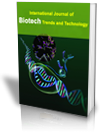Sickle Cell Anemia and Glucose-6-phosphate dehydrogenase (G6PD) deficiency: Impact on Biological and Clinical Parameters
Citation
Mounkaila Boutchi, Amadou Idé Ibrahim, Alhousseini Daouda, Sabo AM Zeinabou, Ali Touré Ibrahim "Sickle Cell Anemia and Glucose-6-phosphate dehydrogenase (G6PD) deficiency: Impact on Biological and Clinical Parameters", International Journal of Biotech Trends and Technology (IJBTT), V6(1): 13-17 Jan - Mar 2016, Published by Seventh Sense Research Group.
Abstract
Both sickle-cell anemia and G6PD deficiency are red blood cell gene abnormalities that cause hemolytic anemia. Their association may have serious consequences. The objective of this study is to determine the prevalence of such an association at the CNRD of Niamey and the impact of G6PD on sickle-cell anemia patients. A prospective cross-sectional study was conducted with 227 major sickle-cell anemia patients in stationary phase by comparing hematological parameters, free and total bilirubin concentrations, impaired hepatic and splenic functions as well as hospitalization and blood transfusion rates. G6PD intra erythrocytic was determined by spectrophotometry at all sickle cell patients on the hemolysate of washed red blood cells. Findings were analyzed by Epi-info 3.5.4 and the significance level was set at P < 0.05. G6PD was found in 7.08% of sickle-cell anemia patients. SS sickle-cell anemia was the most frequent form of the disease (83.3%). Hb levels as well as reticulocyte rates and MCHC were not significantly different in both groups of major sicklecell anemia patients. But, the level of total bilirubin was significantly high in sickle-cell anemia in case of G6PD deficiency. Though the risk of hospitalization was similar in both groups of patients, sickle-cell anemia patients with G6PD deficiency were more likely to develop hepatomegaly or splenomegaly.
References
[1] Beutler E. G6PD deficiency. Blood 1994; 84: 3613-36
[2] Nkhoma ET, Paul C, Vannappagari V, Hall SA, and Beutler. The global prevalence of glucose-6-phosphate dehydrogenase deficiency: a systemic review and metaanalysis. Blood cells, molecules and diseases. 2009; 42: 267-278
[3] Anna L Peters and Cornelis JF Van Noorden. Glucose-6- phosphate Dehydrogenase Deficiency and Malaria: Cytochemical Detection of Heterozygous G6PD Deficiency in Women. Journal of Histochemistry & Cytochemistry 2009; 57(11): 1003–1011
[4] Steinberg MH, West MS, Callaghar D and Mentzer W. Effects of glucose-6-phosphate dehydrogenase deficiency upon sickle cell anemia. Blood 1988 ; 71 : 748-752
[5] Benkerrou M, Alberti C, Couque N, Haouari Z, Ba A. Missud F et al. Impact of G6PD deficiency on sickle cell anemia expression infancy and early childhood: a prospective study. Br J Haematol. 2013; 163 (5): 646-54
[6] Mounkaila B, Oumarou Hamido K, Garba M, Abdoulaye Maiga R, AKpona SA, Sanogo I. Hémolyse chronique des sujets drépanocytaires SS et SC en phase stationnaire: étude comparative au centre national de référence de la drépanocytose à Niamey. Rev. CAMES SANTE 2015 ; 3 (1) : 25-9
[7] Institut National de la Statistique (INS) et ICF International. 2013. Enquête Démographique et de Santé et à Indicateurs Multiples du Niger 2012. Calverton, Maryland. USA: INS et ICF International.
[8] Mounkaila B, Daouda A, Garba RM, Aridouane D. Neonatal glucose-6-phosphate dehydrogenase (G6PD) deficiency in Niamey. International Journal of Biotech Trends and Technology 2016, 13(1), 12-14
[9] Diop S, Thiam D, Sene A, Cissé M, Fall K, Touré-Fall AO et al. Association drepanocytose-deficit en G-6-PD: prévalence et influence sur le profil évolutif. Médecine d`Afrique Noire 2000 ; 47 (7) : 322-6
[10] Gbadoé AD, Atsou K, Agbodjan-Djossou OA, Tsolényanu É, Nyadanu M, Dogba AD, et al. Prise en charge ambulatoire des drépanocytaires : évaluation de la première année de suivi des patients dans le service de pédiatrie de Lomé (Togo). Bull Soc Pathol Exot 2001; 94 (2): 101-105
[11] Nouraie M, Reading NS, Campbell A, Minnitri CP, Rana SR, Luchtmann jones I, et al. Association of G6PD with lower haemoglobin concentration but not increase haemolysis in patients with sickle cell anemia. British journal of haematology 2010; 150: 218-255
[12] Rees DC, Lambert C, Cooper E, Bartram J, Goss D, Deane C et al. G6PD deficiency is notassociated with cerebrovascular disease in children with sickle cell anemia. Blood 2009; 114: 742-743
[13] Bouanga JC, Mouélé R, Préhu C, Wajcman H, Feingold J, Galactéros F. G6PD deficiency and homozygous sickle cell disease in Congo. Hum Hered 1998; 48 (4): 192-7
[14] Simpore J, Ilboudo, damintoti k, sawadogo L. Maria E. et al. Glucose-6-phaosphate dehydrogense and sickle cell disease in Burkina Faso. Pak. J. Biol. Sci., 2007; 10 (3): 409-411.
Keywords
Sickle cell anemia, G6PD deficiency, Hemoglobin, clinical parameters, Niamey.


